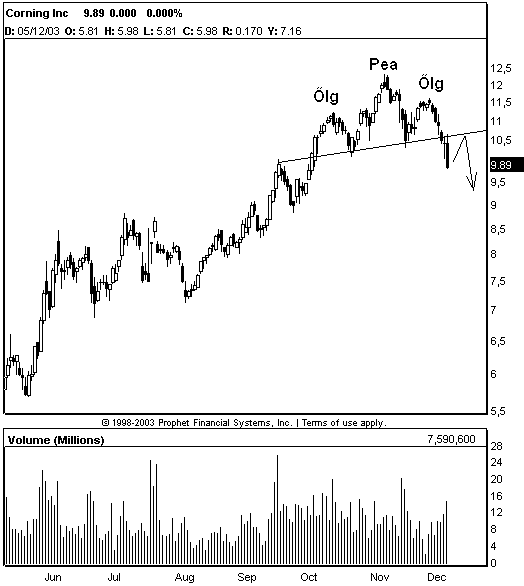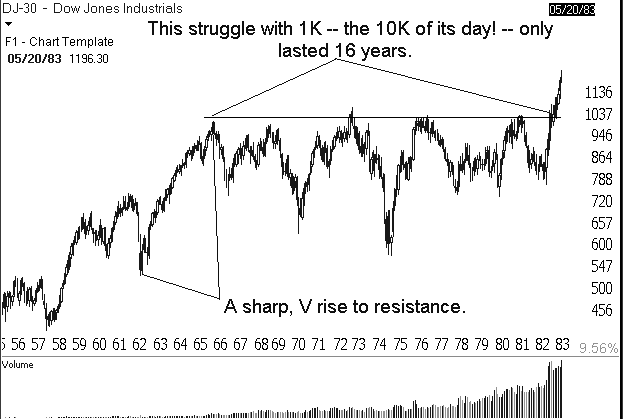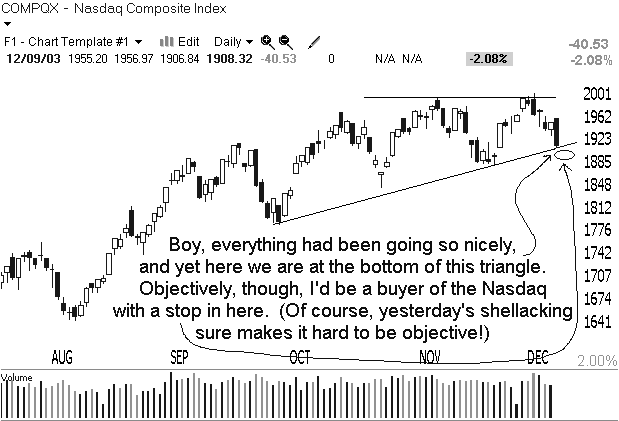Börsipäev 10. detsember - põrge?
Kommentaari jätmiseks loo konto või logi sisse
-
Mõned teemad tänaseks päevaks:
- JP Morgan tõstab täna hommikul Corning Inc (GLW) reitingu Neutraalse pealt Overweight peale. Analüütikute arvates lähevad nii LCD kui ka FTTP (Fiber To The Premises) ärid hästi. Hetkel kauplevad GLW aktsiad circa 25x nende 2005. aasta kasumiprognoosi aktsia kohta, mis muudab need analüütikute arvates odavateks (PEG alla ühe).
Ma tunnen tugevat kiusatust täna hommikul GLW-d lühikeseks müüa selle upgreidi peale. Aktsia on oma tippudest juba 20% alla tulnud, kuid tänane (lühiajaline) ostuhuvi 10.50 kandis pakub mulle ilmselt võimaluse ka nägemust võtta. Tihedad stopid.

- Wall Street Journal kirjutab täna hommikul Microsofti (MSFT)-i suhteliselt kesisest käitumisest selle aasta jooksul. Nimelt on maailma suurima firma aktsiad aasta lõikes vaid 2% plussis. Nasdaq on samal ajal 43% tõusnud. Siiski tunduvad aktsiad praegu odavatena (kaubeldes 26x TTM EPS) ning analüütikute sõnul võiksid Oracle (ORCL) järgmisel nädalal avaldatavad tulemused olla katalüsaatoriks, mis tekitavad ostuhuvi ka Pisipehme aktsiate vastu.
- Schering-Plough (SGP) saab täna hommikul UBS Warburgi käest reitingualanduse. Varasema Neutraalse asemel soovitatakse aktsiate kogust protfellis vähendada (Reduce). Põhjused? Analüütikute arvates ülekõrge valuatsioon. Lisaks sellele on üles loetletud kõik teadaolevad probleemid. Põhimõtteliselt ei midagi uut. Jah, SGP aktsiad võivad tunduda kallitena, siiski tasub meenutada, et uued kasvumootorid on alles startimas.
Veidi positiivsema külje pealt käsitleb SGP-d ning sarnaseid aktsiad täna hommikul Barrons. Seal räägitakse jaanuari effektist, mille järgi väikeste aktsiate tootlus on jaanuaris suurte aktsiate tootlust ületanud kõige suurema marginaaliga. Seda alates 1926. aastast.
Siiski on tänavu SP600 indeks (smallcap) tõusnud 32%. Samal ajal on SP500 (large cap) tõusnud vaid 18%. Sellest tulenevalt usuvad mõnes analüütikud, et Jaanuaris saavad ostuhuvi osaliseks hoopis suured, aasta jooksul kukkunud aktsiad. Fondijuhtide arvates võiksid nende hulka kuuluda: SGP, XOM, BP, RIG, KFT and MO.
- ESS Tech (ESST), mis on tegev DVD seadmete äris, teatas, et jooksva kvartali kasum ning käive tulevad oodatust märkimisväärselt suuremad. ESST on eeleturul 10% plussis ning kaasa haaranud ka konkurendid ZRAN ning CRUS.Tegemist on väga hea märgiga kogu oleelektroonika tootjate sektorile. Oma osa võivad saada ka jaemüüjad.
- Goldman Sachs tõstab täna hommikul Storage-hiiu EMC (EMC) reitingu In-Line pealt Outperform peale. Nende arvates läheb firmal hetkel hästi, hinnasihiks $15. Lisaks sellele tõstab Goldman kogu IT-raudvara sektori reitingu Attractive peale varasema Neutraalse asemel. Ootused on muutumas tõeks.
- JP Morgan alustab online-reisiteenuste pakkuja Priceline (PCLN) aktsiate katmist Underweight reitinguga. Nende arvates on konkurents sektoris juba väga tihe ning PCLN on mängust paljuski välja jäänud. Hetkel omab firma 4% suurust turuosa USA turul.
- Gary B. Smith:
- ReVShark:Good morning. Yesterday afternoon I predicted that the indices would bounce after digesting the FOMC interest rate decision. As Jim Cramer used to say, "Wrong!"
That isn't the first time I've been wrong and it definitely won't be the last. If you are an active trader, inaccurate predictions are something you have to live with on a regular basis. One of the best ways to learn how to deal with being wrong is to make predictions publicly. Make your predictions loud and clear and then be ready to admit it when you are wrong. It can be quite liberating when you realize that mistakes, errors, miscalculations, blunders and screw-ups will be your constant companions in your work as a trader.
Once you are able to acknowledge that you will always be less than perfect when it comes to trading, you are then free to come up with ways to limit the damage that comes from wayward prediction. One of the easiest things to do is to dig yourself in deeper when you are wrong. Rather than cut your losses, you tell yourself you are still right and double down.
The consequence of doubling down after a poor prediction is that you tend to make a stressful situation even more stressful. You now have more on the line and will be even more prone to making emotional decisions if things don't go your way. When you are in too deep, logic tends to go out the window.
Be very careful about compounding errors. When you find yourself on the wrong side of a trade, don't continue to add to your positions. You don't necessarily have to sell if you still think you are correct, but wait for some proof that you are correct rather than stubbornly sticking to your guns and putting more money on the line.Having said that, I continue to feel that we are due for a bounce. In fact, after the almost panicky selling to end the day yesterday I believe it's even more likely. We actually had the slight stench of fear in the air during the closing hour yesterday as the buyers refused to step up.
Because I'm talking about making predictions, I might as well lay out my prediction for the Nasdaq for the next year or so. After the hard selloff yesterday and the recent carnage in technology stocks, I'm looking for some sort of bounce, but I don't think it's going to last for long. Once that bounce fails, the Nasdaq will then crack the November lows and badly scare the bulls. That will give us sufficient worry and concern so that we will set up for a strong rally starting the week of Christmas and lasting into the beginning of January.
I believe that move will be vigorous enough to take us back over Nasdaq 2000 and maybe as high as 2100. After that we roll over hard, see some aggressive profit-taking and struggle for a few months. We than regain our footing and rally into September, when we hit new annual highs but top out and sell off very hard.
The likelihood is very high that my prediction will prove to be incorrect, but I do find it helpful to have some sort of framework in mind as I approach the market. When it becomes clear that I am wrong, then I make some changes to my approach. But this gives me something to consider the daily action against as it unfolds.
In the early going the indices are finding some tentative support. Overseas markets are generally lower but the dollar is finding some strength, especially against the yen, and that is helping our early indications.
The technical picture for the Nasdaq is particularly bleak. We solidly broke the 50-day simple moving average and there is little support on the charts. The DJIA and S&P 500 aren't nearly as bad; they are still holding support levels at the November highs, but you have to wonder if the Nasdaq will eventually spill over and drag those indices down as well.
The cyclical stocks are helping the senior indices but you can't count on that to last for long. We need some leadership, particularly from technology stocks, if the bulls are going to run again.
If we see a bounce today be skeptical of it and consider using it to lighten up on some positions. This market is struggling right now and it is not the time to be aggressively long.
Futuurid: Naz0.14% SP-0.02% -
Kristjan,
kas sinu pakutud LIOX päevasisesed- ja sulgemisSTOPid kehtivad endiselt? -
Vaatasin graafikud üle, tõepoolest - ka praegu tunduvad need tasemed täpsed.
-
Tänane seminar õnnelikult läbi, külalisi oli üle ootuste palju, tänud kõigile. Lisan ka oma presentatsiooni:
-
Eeln -10%, milles asi?
-
Kui WM uudisest tingituna, kas tegu pole ülereageerimisega?
-
Seoses seminariga tekkis küsimus, kas ainuke võimalus rootsi aktsiate kohta infot saada ongi telefoni teel?
-
Mairo
Soome ja Rootsi aktsiate hinnad on meie lehel olemas, kuid 15 minutilise viiteajaga.
Kui Soome aktsiahindu on võimalik reaalajas veel suhteliselt mõõduka hinna eest näha (Rene poolt mainitud Kauppalehtis 52 EUR kuu), siis Rootsi aktsiate puhul on vastavad tasud krõbedamad.
Telefoni teel antav info puudutas reaalajas hindu, mida mina maaklerina näen, Soome aktsiate puhul ka aktsiate tellimusraamatud ehk nn. level 2 nähtav.
-
Lisan nüüd ka oma presentatsiooni ...
Käsitletud teemade osas vastuseta jäänud küsimused on oodatud henno.viires@lhv.ee ja rene.ilves@lhv.ee
-
Artiklist jääb mulje et see tudeng leidis üldse kõige suurema algarvu.
Pakun et tegelikult leidis ta vaid ühe algarvu mis on seni teadaolevaist suurim. Algarvude hulk peaks vsit ikka lõpmatu olema, st pole olemas absoluutselt suurimat algaarvu.
Võibolla lihstal EPL on valesti tõlkinud. -
Ajakirjanikud võiksid mõnikord artiklite kirjutamise/tõlkimise ajal küsida nõu antud teemaga seotud eriala inimestelt, kas või mõnelt tudengilt... Vastasel korral jäävad erialastel teemadel kirjutatud lood igaveseks sama mannetuteks kui praegu. Mina pole siiani aru saanud sellest, kuidas ajakirjanik üldse suudab kirjutada teemadel, mida ta ei valda. Kas keegi teist julgeks kirjutada artikli, mida loeb tuhandeid inimesi, näiteks näokirurgia spetsiifikast?
-
Fun: ega need tuhanded inimesed kah näokirurgid ole :)
-
Rene, loomulikult ei ole, aga see ei ole ju eriline vabandus.
Kuidas suhtuksid sellesse, kui keegi, kes pole kunagi kokku puutunud investeerimisega, hakkaks korraldama investeerimisalaseid seminare? Ega kõik kuulajad ei ole ka ju investorid... ;) -
nagu Sa ilmselt aru said tahtsin ma öelda, et ajalehe müügi seisukohalt pole sellel mingit tähtsust.
tuhanded inimesed vaatavad, et head ajakirjanikud-head artiklid, ala spetsialistid vangutavad ainult pead :)

